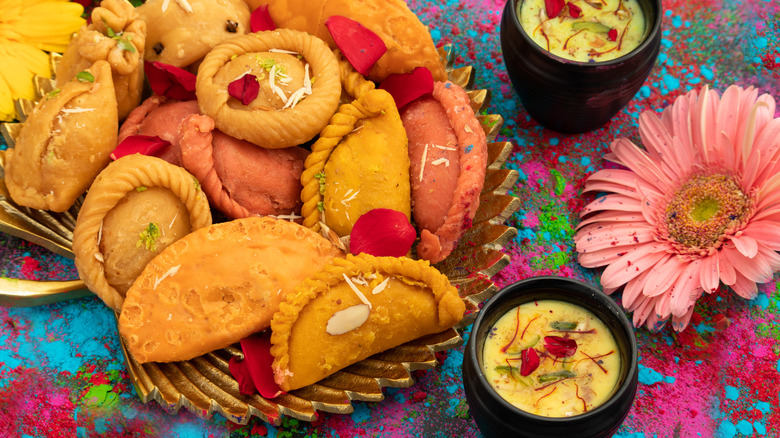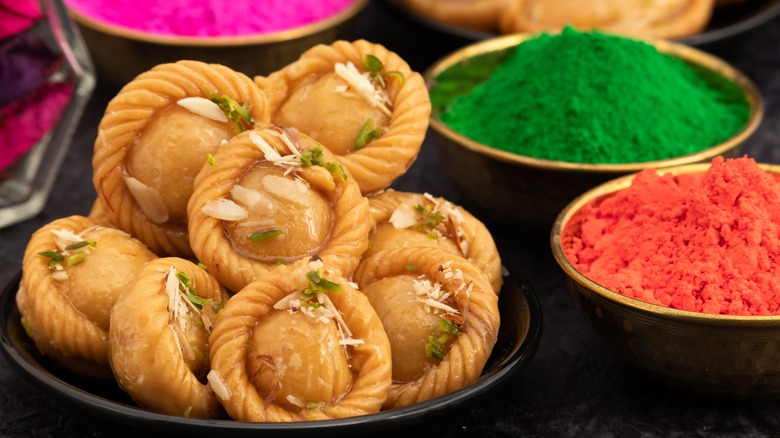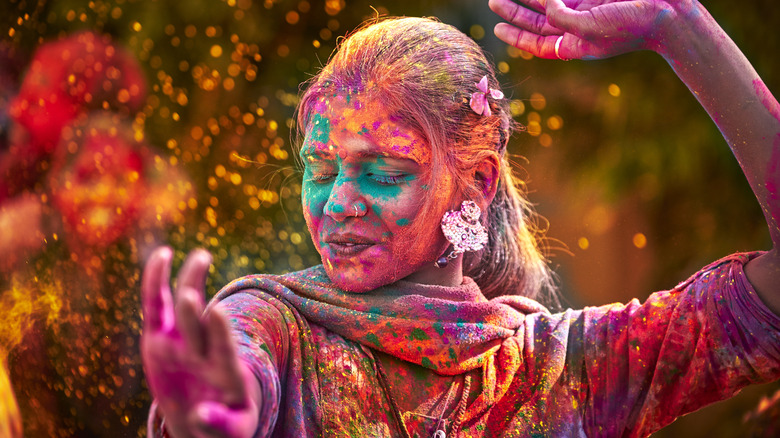Why Gujiya Is Typically Eaten During Holi
Crispy, flaky, and filled with nuts, raisins, and milk fudge, gujiya is the traditional snackable sweet that abounds during the colorful Indian festival of Holi. You'll likely see these half-moon-shaped puff pastries on a color-flecked plate in most households celebrating the festival. Revelers generally smear each other with vibrantly colored powders and are then offered a snack platter, on which the gujiya reigns supreme.
Interestingly, the origin of the festival and the sweet are quite different. The former is steeped in Hindu mythological lore of the triumph of good over evil and the seasonal shift from winter to spring. Gujiya's origins, on the other hand, lie somewhere between Turkish and Persian influences and royal delicacies from the central Indian region of Bundelkhand. However, there may be some clues as to the connection between the two if we consider similar Indian sweets called Chandrakala and suryakala, which draw their names from the moon and sun, respectively.
Present-day Holi celebrations are incomplete without gujiya — the sweet that changes form, filling, and name across different parts of India (it also goes by nevri, ghughra, karanji, or pedakiya, depending on the region). There are kitchen tools specific to gujiya-making, like the dainty spoon used for filling, which has a serrated wheel on the other end used for sealing the sweets and giving them their iconic ridged edge. Whether at an Indian restaurant or at home, every bite of gujiya you savor during the Holi festival is loaded with tradition, history, and sweet, flaky deliciousness.
Different lands, different Gujiyas
Some trace gujiya to the crispy, layered Turkish sweet baklava, made of puff pastry and pistachio and soaked in sweet syrup. But even accounting for differing local tastes and ingredients, modern versions of the two sweets are worlds apart. Gujiya is filled mainly with milk solids (khoya) and is deep-fried, while baklava is layered, baked, and filled predominantly with pistachios. However, since Turkey and central India were part of the famous Silk Trade route, there was undoubtedly significant cultural cross-pollination of recipes.
The earliest mention of a dish like gujiya is from the 13th century and refers to a sun-baked sweet made by wrapping a mixture of raw sugar and honey in dough. Other sources trace gujiya to the north-central Indian region of Bundelkhand around the 16th and 17th centuries. The connection between Holi and gujiya also appears to stem from this region, as the people of Bundelkhand served balls of flour dipped in sweet syrup to deities of Lord Krishna during the last full moon of winter, which is when Holi is celebrated.
Finally, gujiya can be considered the sweet version of the savory samosa, which is also stuffed and deep-fried and originated in the Middle East around the 10th century. And like the latter, which is now an iconic Indian dish, several versions of gujiya also abound across India. Depending on the region, stuffing can include coconut, dry fruits, rose petal preserve (gulkand), and sweetened semolina — a type of Indian pudding called halwa.
The Holi connection
Though you may see the odd gujiya around the year and at other major Indian festivals like Diwali, this sweet snack is omnipresent during Holi, which marks the advent of spring and is celebrated on the last full moon of winter. The day, called "Falgun Purnima" in India, is an important one in the lunar calendar and is known by different names around the world, like the Native American "Worm Moon," the Chinese "Sleepy Moon," and the Christian "Lenten Moon." The gujiya's half-moon shape is a tenuous connection; still, it does start to make sense when we look at a round version of the sweet, which resembles the Moon and is called Chandrakala (Chandra means Moon in several Indian languages). It is similar to the significance of dumplings during the Lunar New Year.
The other connection between Holi and gujiya appears to be through the mythological figure Krishna — who is known for his fondness of sweets and love for his partner, Radha. As the story goes, to make her look like him, Krishna, who is said to have blue skin, smeared Radha with color. Hence, Holi is celebrated by spreading sweets and colors among friends and family. There are also other mythological backstories to Holi, including the burning of the demoness Holika, which is signified by lighting a bonfire on the eve of Holi. However, as far as gujiya is concerned, the sweet story of Krishna's fondness for sweetmeats seems more significant.


